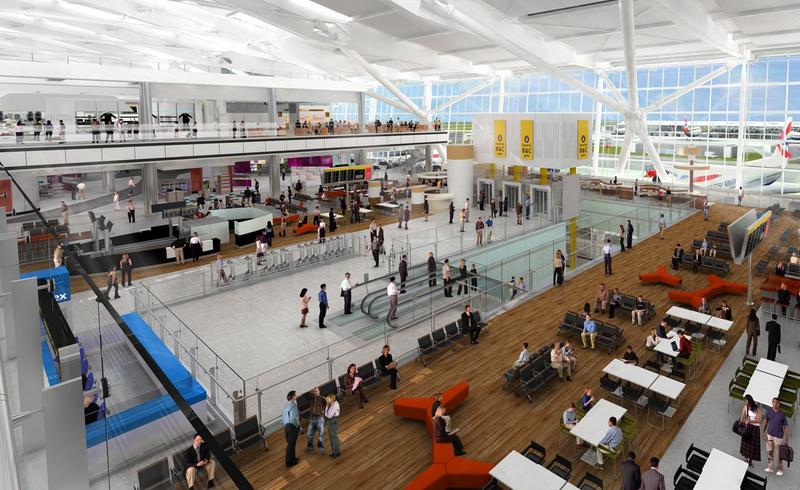Terminal 5 opening 'helped not hindered' by IT
The IT brains behind the development of Heathrow's much-anticipated Terminal 5 have vowed that the technology involved will be integrated and tested properly so that its doors open on time.


Heathrow Airport's 4.3 billion fifth terminal building will be delivered on time and within budget, but won't suffer the delays and hiccups that have blighted major construction projects in recent years, according to the two main parties involved in development, British Airways (BA) and BAA.
However, it's not just in their financial and commercial necessity to make Terminal 5 a success. It is essential that everything is ready, willing and able to serve 30 million-plus passengers a year from March 2008, if Heathrow is to maintain its position as the world's busiest airport, cope with major events such as the 2012 Olympics and ensure that London remains a global gateway for international travel and tourism.
To ensure deadlines aren't missed and key details overlooked, integration has been key to planning and development, according to Nick Gaines, BAA's director of business critical systems and IT.
"Almost every airport in history has opened late, cost more and had major operational difficulties in its first days, months or years of operation. The most common explanation is the quaint phrase that they had system integration problems. That will not be the case with Terminal 5," he said.
"Such projects present unique challenges in terms of construction and from an IT perspective. Even the supporting environment [while the site was being built] involved creating a small town at the end of Heathrow with telecoms and other IT equipment usually only found in international consultancies."
Gaines added: "Most of our systems have been trialled in other airports so they will have reached a state of maturity when Terminal 5 opens. It's about risk management and working out when we need to make decisions and about using open standard, avoiding unproven technologies and knowing where to integrate and where not to. Integration is not just about putting IT systems together, it's about bringing people and processes together too."
Indeed, there is an awful lot to bring together. Terminal 5 is a hotbed of technology, with 2.3 million metres of cabling, 163 systems, 546 interfaces, more than 2,000 PCs, 5,000 mobile devices and 96 self-service kiosks all being primed for operational readiness when the new terminal officially opens its doors next year.
Get the ITPro daily newsletter
Sign up today and you will receive a free copy of our Future Focus 2025 report - the leading guidance on AI, cybersecurity and other IT challenges as per 700+ senior executives
Terminal 5 will be used exclusively by BA and will help improve the travel experience for passengers, something which has suffered in light of recent security and congestion problems at all of Heathrow's terminals.
While this will deliver a much needed commercial boost for BA and its landlord, the airport operator BAA, the investment being ploughed into Terminal 5 and the knock-on effects on the rest of the airport will have a much wider-reaching impact, according to Paul Coby, chief information officer at BA.
"The UK can't act as a global hub unless we have a world class airport. Terminal 5 and our investment in Heathrow Airport is absolutely a key element in the [success of] the UK economy and positioning us as a global hub," he said. "It's also the global hub for BA and is fundamental to our customer service and our future."
Coby added: "Terminal 5 for me encapsulates how a 21st century information management (IM) department plays a part in the business... In the past, people have focused on IT and thought a bit about proposition and processes at the end of a project," he said. "At BA, we have tried to think 'What's this building for? What are we trying to do?' That's about processes and how they affect people and the design of IT. Terminal 5 is our biggest challenge but it's also our biggest opportunity to do this."
As well as the behind the scenes technology and plans to test the operational strength of the new terminal later this year with trial passengers, BA also plans to increase its focus on using technology to enhance the customer experience before people head for the departure gate.
Maggie has been a journalist since 1999, starting her career as an editorial assistant on then-weekly magazine Computing, before working her way up to senior reporter level. In 2006, just weeks before ITPro was launched, Maggie joined Dennis Publishing as a reporter. Having worked her way up to editor of ITPro, she was appointed group editor of CloudPro and ITPro in April 2012. She became the editorial director and took responsibility for ChannelPro, in 2016.
Her areas of particular interest, aside from cloud, include management and C-level issues, the business value of technology, green and environmental issues and careers to name but a few.
-
 Bigger salaries, more burnout: Is the CISO role in crisis?
Bigger salaries, more burnout: Is the CISO role in crisis?In-depth CISOs are more stressed than ever before – but why is this and what can be done?
By Kate O'Flaherty Published
-
 Cheap cyber crime kits can be bought on the dark web for less than $25
Cheap cyber crime kits can be bought on the dark web for less than $25News Research from NordVPN shows phishing kits are now widely available on the dark web and via messaging apps like Telegram, and are often selling for less than $25.
By Emma Woollacott Published